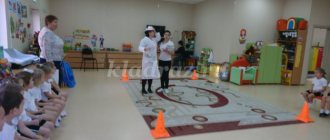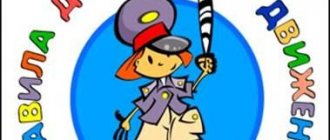The basic component of preschool education states that the child must “have an idea of cognitive activity in his own development, be interested in the peculiarities of his perception, memory, imagination, thinking; master the initial forms of research, experimentation, and simply study the world around us.” Preschool age is the age of “why”. Why is the rainbow multicolored? Where does the breeze come from? When did dinosaurs go extinct? Why is the water wet? How many more different questions do you have to hear and look for answers for little “curious” people?
How to teach a child in the modern world of innovative technologies, computerization and a huge number of television programs and literature to find the necessary information. In this regard, there is a need to choose more effective methods of education and training that give children the key to understanding reality, and not an exhaustive amount of knowledge. In preschool age, the main structural component of cognitive development becomes problematic, which ensures the child’s constant openness to new things and is expressed in the search for inconsistencies and contradictions.
The experience of my teaching activity confirms that when children are captivated by current events, when they have a certain amount of knowledge and impressions about a given phenomenon, they can set new tasks themselves, come up with game actions and ways to carry them out. Therefore, I begin training and education not with the transfer of “ready-made” knowledge and skills, but with the formulation of problematic tasks, in the process of solving which cognitive activity develops and creative abilities are formed.
I believe that if you use project activities as a means of cognitive development, this will contribute to the formation of specific skills, general educational and communicative skills; will develop the creative activity of children in the process of play and cognitive activity; activates the desire and ability to create new images and projects; invent and solve more complex problems, achieving success; will open up great opportunities for the teacher to activate the mental activity and personality development of preschoolers.
The method of project activity is based on a person-oriented approach to training and education, it develops interest, curiosity, develops cooperation skills and practical skills.
In the Russian Pedagogical Encyclopedia, the project method is defined as “a teaching system in which students acquire knowledge and skills in the process of planning and performing gradually more complex practical tasks - projects” [vol. 1, p. 567].
In Latin, where the word “projectus” comes to us, this participle means “thrown forward,” “protruding,” “conspicuous.” In pedagogy, a “project” is usually understood as a special creative situation when a person ceases to be the owner of an idea: he abandons the personal in order to collectively find a solution to the problem posed.
The project method is not fundamentally new in world pedagogy. The founders of this method were the American philosopher and teacher J. Dewey and his student
W. H. Kilpatrick. Of course, over time, the idea of the project method has undergone some evolution. Born from the idea of free education, it has now become an integrated component of the education system. But its essence remains the same - to stimulate the child’s interest in problems. When using the project method, I adhere to the following requirements: The presence of a significant problem in a creative research plan. Practical, cognitive significance of the expected results. Independent (individual, pair, group) activities of children. Project structuring (stage-by-stage results). Use of research methods: - identification of the problem and the ensuing research objectives; — putting forward hypotheses for their solution; -discussion of research methods; -discussion of ways to form final results (presentation, defense, creative reports, screenings); — collection, systematization, analysis of the data obtained; — summing up, drawing up the results, their presentation; - conclusions, raising new problems. In my work I use the following forms of children's projects. Research: “Why do tears flow”, “Why do nails grow”. Educational: “How bread came to our table”, “In the garden or in the vegetable garden”, “The beloved beauty of Russia”, “Pets”. Creative: creation of the album “Big Book of Children's Stories”, creation of the “Red Book of Animals and Plants of the Urals”, creation of the Museum “Petushka”, creation of the tabletop theater “Kolobok”. Gaming: “Traveling around the city of Orsk”, “Flight to Mars”, “Building a city of the future” In terms of duration, projects can be short-term (1 lesson) and long-term (from one week to several months), they can be individual and group. I begin work on the project by drawing up a well-founded action plan, which is formed and refined throughout the entire period and takes place in several stages: - Goal setting; — Search for a form of project implementation; — Development of the content of educational work based on the topic of the project; — Organization of a developmental, cognitive, subject environment; — Determination of directions for search and practical activities; — Organization of joint activities with teachers, parents and children; — Work on the project, its correction; — Collective implementation of the project, its presentation, defense. Planning the project “Pets” (2ml.gr.) through OED (organized educational activities), joint activities of adults and children, independent activities of children in educational areas. COGNITION: Didactic games: “Whose house”, “Who helps a person how”, “Whose children are these”, “Find mom”, “Who screams how”, “Tower for the Cockerel”, “I know 5 names of pets”, “ What will you do”, “Who eats what”, “The third wheel”, “What has changed”. Experimentation: “Let's treat the dog to grass”, “Feeding the cat”, “Rabbit and cat - who is better?”, “What happens if a pet is released into the wild?” Construction: “Let’s build a home: a kennel for a dog, a chicken coop for a chicken, a barn for a cow.” COMMUNICATION: Compiling the story “Find Mom” according to the scheme: color – nose – ears – eyes – tail – hooves – horns. Children's stories on the topic: “My favorite animal”, “Description of a cat” (toy). Imitation game: “Who walks how”, “Sleeping baby”. Composing a fairy tale: “How a little goat was looking for its mother” according to the suggested beginning. Guessing riddles. Examination of the paintings: “Cat and cat with kittens”, “Dog with puppies”. Game dramatization “Cat House”, “Sparrows and the Cat”. Situations - communication: “How I take care of animals”, “How a kitten became friends with a puppy”, “Help Pinocchio find out which child belongs to which mother”, “Why does a hen teach a chicken to cluck”, “Why does the Barbos puppy get sick”, “Like a wild cat decided to become a pet,” “What happens if a kitten is fed hay.” Physical exercises. Finger gymnastics. ARTISTIC CREATIVITY: Drawing “Let's go herd animals in the green meadow”, “Cat” (let's finish drawing the cat). Application: “Different cats are needed, different cats are important.” Modeling: “A milk cup to feed the young,” “Soft paws, and scratches in the paws.” SOCIALIZATION: Work with parents: photo exhibition “Our Pets”, survey “Cultivating love for animals”. Exhibition of joint crafts “Pets”, moving folders, consultations: “Animals are the best therapists for you and your children.” Creation of a mini museum of Cockerel. Psycho-gymnastics “Happy and Sad Animals”. Story situation “Tanya came home from a walk, sad - the Cockerel got lost.” Tabletop theater based on Chukovsky's fairy tale "Chicken". READING FICTION: Reading: O. Vysotskaya “Cat”, G. Vieru “Chicken”, Chukovsky “Chicken”, Villager “Kitten”, V. Berestov “Kitten”, D. Kharms “Chicken” and Duckling”, I. Chapek “The Adventure of a Dog and a Cat”, N. Nosov “Who Said “Meow”. Reading nursery rhymes “I will tie the goats to the white birch tree”, “How I love my little cow!” V. Suteev “Three kittens”. Counting rhymes: “A goat was walking along the bridge”, “A zealous horse”, “A pig was walking through the forest”. Memorization: r.n. song “Kitsonka Murysonka”, “The cat went to the stove”, “Kitten - cat”. PHYSICAL EDUCATION: Outdoor games: “The chicken went out for a walk”, “I am a cow…”, “Cat with kittens”, “Cockerels”, “Shaggy dog”, “Sparrows and the cat”, “Cat and mice”, “Shepherd and sheep” ", "Sick cat", "Plasticine figures". MUSIC: Listening: “Cat” (music by Alexandrov, lyrics by Frenkel), “Dog” (music by Rukhverg, lyrics by Komissarov), “Grey Kitty” (music by Vitlin, lyrics by Naydenov). Listening to audio recordings of pets' voices. WORK: Work assignments, joint activities in caring for pets. HEALTH AND SAFETY: Conversations “How and why cats wash themselves”, “Is a dog friend or foe?” Planning the project “Bread is the head of everything” by type of activity. Organized educational activities: 1. CONVERSATIONS - “The process of growing bread” - “Cereals” - “Getting to know the production process” - “What bread is made from” - “Rye and wheat bread” - “How can we save bread” - “Bread in Rus'" - "Bread from different countries" - "I'm glad to put the bread on the tablecloth, it's like the sun on it." 1.2.READING STORIES - “I’m here” by Y. Taits - “Fox Bread” by M. Prishvin - “Bread” by M. Glinskaya 1.3.GUESSING RIDDLES 1.4.LEARNING PROVERBS, SAYINGS, POEMS ABOUT BREAD - “bread” by Y. Akim - “ Rye" J. Dyagutyte 1.5. TELLING FAIRY TALES - "Kolobok" Russian folk - "Kolobok" Russian folk - "At the mill" German folk 1.6. EXPERIMENTAL ACTIVITY - “How to turn grain into flour” - “What determines the taste of the product” - “How to prepare sour dough” - “Comparison of the taste of products made from different grains” 1.7. EXAMINATION OF PICTURES - “Plowing”, “Sowing”, “ Cleaning", "Winter crops", "Rye". I.I. Shishkina. 1.8.MAKE FROM SALT DOUGH - “I bake, bake, bake...” 2.Photo exhibition “Bread and Children” 3.Exhibition of crafts made from salt dough 4.Design of an album about bread - “Bread is a treasure, take care of it, in moderation for dinner take it" 5. Excursions - to a bread store; - to the kitchen 6. Meetings with interesting people - with a pastry chef; — with a baker 7. Exhibition of drawings “He is famous for being the first on Earth” 8. Museum of Bread 9. Theatrical activities — panorama theater with musical accompaniment “Dove and Grain of Wheat” — tabletop theater “Spikelet” — dramatization “At the Mill” — puppet theater "Kolobok" 10. Entertainment - "Harvest Festival" - "Spring is red with flowers, and autumn with sheaves" - "Bread is life" - "Feast of the loaf" - "Fair" - KVN "Bread and porridge is our food" 11. Game activities - role-playing games: “Bread store”, “Guests have arrived”, “Where the bread came from” - didactic games: “Taste”, “Know by smell”, “Know by touch”, “Professions” - word games : “Say differently”, “Who can name more dough products”, “What first, what then”, “What was done wrong”, “We won’t tell you what we did, but we’ll show you how we did it” 12. Labor activity - growing cereals for bird feed; - preparation of straws for crafts: - manual labor using cereals, straws; — making crafts from dough; — testoplasty; — design of mini albums, children’s books about bread. 13.Work with parents - Parent meeting “Cultivating a caring attitude towards bread”; — “Share your recipe” competition; — Dad’s workshop: making a model “How bread came to our table.” The project “The Beloved Beauty of Russia” was developed using the “system web” method. COGNITION The leading activity is cognitive and research. Forms: DED (direct educational activity): - excursion to a Russian hut; acquaintance with the national Russian costume; meeting a rag doll; acquaintance with the nesting doll; Bogorodskaya toy; Dymkovo horse; Filimonovskaya whistle. SOCIALIZATION V.D. – gaming. Forms: Conversations: “I live in Russia”, “I am a girl”, And I am a boy”, “My favorite toy”; role-playing games “Family”, “Dressing a doll”. HEALTH V.D. – integration. Forms: finger games; Healthy lifestyle – acquaintance with folk traditions. ARTISTIC CREATIVITY V.D. – productive. Forms: GCD in fine arts: acquaintance with folk crafts (Gzhel, Khokhloma, Zhostovo); applique; modeling; manual labor. READING FICTION V.D. – reading. Forms: GCD acquaintance with Russian folklore (sayings, proverbs, riddles, reading fairy tales). LABOR V.D. – labor. Forms: DIY Toys workshop); acquaintance with professions (weaver, potter, blacksmith, baker). PHYSICAL CULTURE V.D. – motor. Forms: thematic physical exercises. MUSIC V.D. – Musical and artistic. Forms: acquaintance with Russian folk songs, dances, chants, ditties. COMMUNICATION V.D. – communicative. Forms: role-playing games, theatrical activities, educational activities for speech development (composing descriptive stories about toys, stories from personal experience). SAFETY V.D. – integration. Forms: introduction to amulets. FORMS OF INTERACTION WITH FAMILY AND SOCIAL PARTNERS Forms: entertainment “Russian Fair”, “Maslenitsa”, creation of the “Museum of Folk Toys”, exhibition of folk crafts, exhibition of drawings “Folk Crafts”. MOMENTS V.D. – integration of different types of activities. Forms: examination of illustrations, albums, filmstrips, acquaintance with folk toys. When developing projects, I use the “Three Questions Model”, the “Three I” technology, and the “Seven We” image. I always involve parents in the children’s activities, because... One child cannot cope with search and creative activities. I offer children and parents different tasks: prepare an album, layout, poster, collect a herbarium, make a craft, take a photograph, draw, etc. I carefully think through the tasks so that they are not too labor-intensive and are completed with desire and joy, and if necessary, I provide reference practical material or recommend where it can be found. The most striking and spectacular stage is always the last stage – the defense of the project. I always invite parents and guests to defend me. And for the child it is also responsible and significant. It is at this moment that the highest point of emotional intensity occurs, due to the social significance of the project. The project defense form is bright and interesting in such a way as to highlight and demonstrate the contribution of each child, parent, and teacher. Exhibitions of joint creativity always attract the attention of all children and parents, not only of our group, but of the entire kindergarten. I share my work experience with teachers, speaking at teacher councils and posting video materials on the kindergarten website (see video clip). Analyzing the results of the work on introducing the project method, I came to the following conclusions: work on the project is of great importance for the cognitive development of the child, for the development of the child’s creative abilities. In the preschool period, integration occurs between common methods of thinking, speech, art and other types of activity. Visual arts skills improve, hand motor skills develop, the preschooler’s vocabulary is activated and enriched, contacts with other children and adults are easily established, and the ability to think independently and draw conclusions is formed. The project method provides a good opportunity for insecure and shy children to realize their creative abilities. Working on a project develops communication and moral qualities: the ability to negotiate, show patience and respect for each other, and the ability to listen to the opinions of others. Of great importance is the relationship between the teacher and parents, who become not outside observers, but participants involved in the educational process. The development of such qualities prepares the child for success in school. REFERENCES: 1. Erofeeva T.I. Modern educational programs for preschool institutions. - M, 2000. 2. Zhuravleva V.N. Project activities of older preschoolers. - Volgograd: Teacher, 2009. 3. Zaire-Bek E.S. Fundamentals of pedagogical design. - St. Petersburg, 1997. 4. Kiseleva L.S., Rakilina T.A., Zuikova M.B. Project method of activity of a preschool institution. -M. : ARKTI, 2005. 5. Nikitina I.V. Innovative activities of a modern teacher. - Volgograd: Teacher, 2007. 6. New pedagogical and information technologies in the education system / Ed. E.S.Polat/. -M. 2000. 7. Stupnitskaya M.A. New pedagogical technologies: learning to work on projects. -Yaroslavl: Development Academy, 2008.


